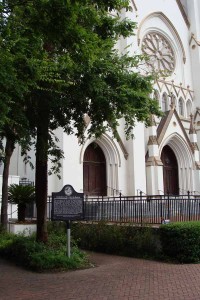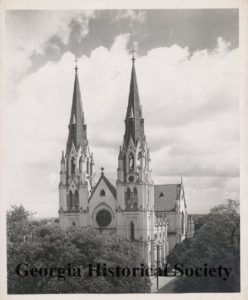In honor of the 2016-2017 Georgia History Festival, “A State of Innovation,” the February #MarkerMonday posts will focus on Savannah, the founding city of Georgia, and the many different groups of people that came to settle in Georgia. Over the course of the month, these posts will discuss four different communities that settled in Savannah and south Georgia.
 This week’s #MarkerMonday highlights the history of early Catholicism in Georgia. Prior to the founding of the Colony of Georgia, the Spanish operated multiple catholic missions on Georgia’s barrier islands and along the coast, however the missions did not survive the establishment of the British colony in 1733. Historically, the Spanish were Roman Catholic and Georgia’s English founders feared that Catholic settlers might be sympathetic to the Spanish if conflict erupted between the two world powers. The ban on Catholicism remained in place until the American Revolution. During this time, the emphasis placed on individual liberties, including freedom of religion, helped to overcome the prejudice harbored by many toward Catholics. In 1777, the State of Georgia assured Catholics the right to practice their religion but would not allow them to hold office. Catholicism began to gain ground in Georgia after the formal acceptance of the US Constitution in 1789, when Catholics received equal rights under law. In the 1790s, several Catholic families from Maryland settled in an area called Locust Grove, near modern day Sharon. They established the first Catholic Church in Georgia, and a priest was sent from Baltimore. The Locust Grove community grew when French, fleeing the French Revolution and, later, several Irish families arrived in Georgia.
This week’s #MarkerMonday highlights the history of early Catholicism in Georgia. Prior to the founding of the Colony of Georgia, the Spanish operated multiple catholic missions on Georgia’s barrier islands and along the coast, however the missions did not survive the establishment of the British colony in 1733. Historically, the Spanish were Roman Catholic and Georgia’s English founders feared that Catholic settlers might be sympathetic to the Spanish if conflict erupted between the two world powers. The ban on Catholicism remained in place until the American Revolution. During this time, the emphasis placed on individual liberties, including freedom of religion, helped to overcome the prejudice harbored by many toward Catholics. In 1777, the State of Georgia assured Catholics the right to practice their religion but would not allow them to hold office. Catholicism began to gain ground in Georgia after the formal acceptance of the US Constitution in 1789, when Catholics received equal rights under law. In the 1790s, several Catholic families from Maryland settled in an area called Locust Grove, near modern day Sharon. They established the first Catholic Church in Georgia, and a priest was sent from Baltimore. The Locust Grove community grew when French, fleeing the French Revolution and, later, several Irish families arrived in Georgia.

Cathedral of St. John the Baptist. Image Courtesy of the Georgia Historical Society, Foltz Photography Studio Collection, 1899-1960, 1360-05-04-02
During this time, the congregation of St. John the Baptist formed when French émigrés fleeing revolutions in France and Haiti found refuge in Savannah. The congregation continued to grow as more Catholic immigrants came to Georgia. In 1800, the cornerstone for the Church of St John the Baptist was laid. The church moved to a site on Drayton and Perry Streets in 1811 after experiencing years of growing pains. The church became a cathedral in 1850 when the Diocese of Savannah was established. In 1870, Bishop Ignatius Persico introduced plans for the building of a new cathedral and secured land for the building project from the Sisters of Mercy in exchange for a land lot on East Taylor and Lincoln Streets. The Most Reverend James Roosevelt Bayley, Archbishop of Baltimore, dedicated to “Our Lady of Perpetual Help” at its present day site (Lafayette Square) on April 30, 1876. The Cathedral retained the name for ten years, before resuming its title of Cathedral of St. John the Baptist.
Top Image: Interior of Cathedral of St. John the Baptist, Courtesy of the Georgia Historical Society, Foltz Photography Collection, 1899-1960, 1360-05-04-08
Explore the links below to learn more about the history of early Catholicism in Georgia and Cathedral of St. John the Baptist.
GHS is proud to house the Joan B. Williman Notebooks, containing research notes relating to French refugees to South Carolina and Georgia. Willliman also wrote a manuscript on French émigrés and refugees who came to Charleston because of the French Revolution and insurrections in the West Indies. This manuscript can be found in GHS’ Walter C. Hartridge Collection. GHS is also proud to house the Marmaduke Hamilton and Dolores Boisfeuillet Floyd Papers, containing unpublished manuscripts about the history of early Roman Catholics in Georgia as well as the history of the Cathedral of St John the Baptist in Savannah.
The Sisters of Mercy and St. Mary’s Home
The Church of the Purification: Locust Grove Academy
Hidden Histories: Cathedral of St. John the Baptist
New Georgia Encyclopedia (Catholic Church)
New Georgia Encyclopedia (French Presence in Georgia)
Oglethorpe and Religion in Georgia
Cathedral of St. John the Baptist: Church History
Cathedral of St. John the Baptist: About
The Roman Catholic Diocese of Savannah: Our History
Georgia Archives- Constitution of the State of Georgia, 1777
Historic Rural Churches of Georgia: Locust Grove Catholic, Org. 1792
